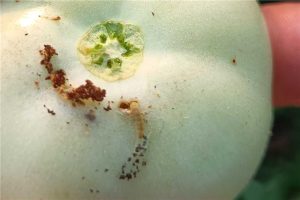Tuta absoluta, commonly known as the American pinworm, is a significant pest of tomato plants. It poses a major threat to tomato crops due to its highly damaging nature throughout its life cycle. The impact of Tuta absoluta infestation on tomato crops can be severe, often resulting in substantial crop losses. Infestations by this pest can lead to yield losses ranging from 60 to 100%. Integrated pest management strategies involving the use of biological control agents, cultural practices and judicious pesticide application are crucial in managing Tuta absoluta infestations and minimizing crop losses.
Host plants affected by the American Pinworm
Tuta absoluta primarily infests tomato plants (main host). However, it is also known to attack other plants belonging to the Solanaceae family such as potato, brinjal, tobacco and peppers.
How does it cause damage?
- The larvae of Tuta absoluta feed on the leaf tissue and mine into the leaf layers.
- They are characterized by irregular, necrotic ‘blotch – type’ mines in leaves.
- It burrows into the fruit making small pin head sized holes around fruit, hence it is referred as ‘Pinworm’.
- Severe infestation will lead to a decrease in photosynthetic activity making plants very weak and drying of infested plant parts.
- Fruits show puncture marks where the larva has entered on the fruit surface, with abnormal fruit shape and larvae exit holes.
- These holes may serve as secondary source for pathogen infection causing fruit rot.
- The presence of larvae, along with their frass (feces), can be observed inside the mines or tunnels on the leaves or in the damaged fruits.

Presence of larva along with their frass
Preventive Measures to Control Tuta Absoluta in Tomato
- Rotate tomato crops with non-solanaceous crops like legumes, cabbage, cauliflower or leafy vegetables to disrupt the life cycle of Tuta absoluta.
- Remove and destroy infested leaves and fruits.
- Plough the field during summer months to expose and kill the pupae.
- Set up 8 – 10 Delta pheromone trap/water trap along with tapas pinworm pheromone lure per acre.
- Install 4 – 6 yellow sticky traps per acre to monitor the pest population.
- Spray Neem oil at 5 ml/lit of water every 10 – 12 days interval.
- Avoid growing tomato crops in close vicinity with alternate host crops.
Tuta Absoluta in Tomato Chemical Management
| Product name | Technical content | Dosage |
| Benevia Insecticide | Cyantraniliprole 10.26% OD | 2 ml/lit water |
| Takumi Insecticide | Flubendiamide 20% WG | 0.5 gm/lit water |
| Lancer Gold Insecticide | Acephate 50 % + Imidacloprid 1.8 % SP | 2 gm/lit water |
| Sivanto Bayer Insecticide | Flupyradifurone 17.09% SL | 2 ml/lit water |
| Ekalux Insecticide | Quinalphos 25 % EC | 2 ml/lit water |
| Syngenta Voliam Targo | Chlorantraniliprole 4.3% + Abamectin 1.7% SC | 1 ml/lit water |
| Keefun Insecticide | Tolfenpyrad 15% EC | 2 ml/lit water |
(Note: Use these chemicals judiciously and follow only the recommended dosage to avoid resurgence of the pest. Check the product’s label to know the right time of application)
Read About Effective Methods to Control Tuta Absoluta in Tomatoes: Learn More





